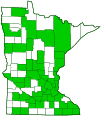Ohio buckeye
(Aesculus glabra var. glabra)
Conservation • Wetland • Description • Habitat • Ecology • Use • Distribution • Taxonomy
Description |
||
Ohio buckeye is an erect, small to medium sized, slow growing, moderately long lived, deciduous tree. It can be from 20′ to 60′ tall at maturity, though it is rarely more than 40′ in height and 24″ in diameter at breast height. In Minnesota it is usually no more than 30′ in height. It reaches full size in 60 to 80 years. The trunk is short and much branched. In the forest the crown is oblong with ascending branches. When in the open the crown is spreading and broadly rounded. The bark on young trees is thin, yellowish-brown, and smooth. As it ages it becomes dark grayish-brown and develops shallow fissures and corky, scaly plates. On mature trees the bark is brownish-gray, rough, and deeply furrowed with thick, scaly plates. Older bark has an alligator hide appearance and is often lighter gray. The twigs are stout and reddish-brown to ashy gray. They have moderate-sized pith and a very disagreeable odor when broken. The leaf scars are large, broad, and shield-shaped. They have 3 bundle scars. Terminal buds are reddish-brown, ½″ to ¾″ long, egg-shaped, and widest at the middle. They are covered with several pairs of triangular, overlapping scales that are ridged in the middle. The scales are covered with a powder and are not sticky. Lateral buds are similar but much smaller. The leaves are deciduous, opposite, and pentagonal, kidney-shaped, or almost circular in outline. They are palmately divided into usually 5, rarely 7, leaflets. Each leaf is on a slender, 3″ to 6″ long, hairless leaf stalk (petiole). The petiole is about as long as the terminal leaflet. The leaves appear in the early spring. The earliest leaves are sometimes killed by a spring frost. The leaflets are mostly inversely egg-shaped to elliptic, 2¾″ to 6¼ long, and 1¼″ to 2⅜″ wide, sometimes wider. They are tapered at the base and long-tapered to a point at the tip. The upper surface is yellowish-green, bright green, or dark green, and either hairless or minutely short-hairy along the veins. The lower surface is usually paler green, and is sparsely to densely covered with short and curly, sometimes with long and woolly, hairs, sometimes just along the veins. The margins are finely and irregularly toothed with sharp, forward pointing teeth. In autumn the leaves turn yellow and are among the first to drop. The flowers appear after the leaves from March to May. Each tree bears both bisexual (perfect) and male (staminate) flowers. The inflorescence is an upright, pyramid-shaped, 4″ to 6″ long, branched cluster (panicle) at the end of smaller branches. The flowers near the base of the branches of the panicle are perfect, the remaining are staminate. The flowers are ¾″ to 1¾″ long. They have 5 sepals, 4 petals, 7 stamens, and 1 style. The sepals are yellow to greenish-yellow and are fused at the base into a more or less bell-shaped tube (calyx) with 5 rounded lobes. The petals are greenish-yellow, ⅜″ to ¾″ long, and narrowed to a stalk-like base (clawed). The upper pair is more or less inversely lance-shaped and gradually tapered to the clawed base. They sometimes have an orangish or reddish central region and/or spots. The lower pair is shorter and broader, and is abruptly tapered to the claw-like base. The stamens protrude well beyond the corolla. They have white, ⅝″ to ⅞″ long stalks (filaments) and orange anthers. The style is white, unbranched, and longer than the stamens. The fruit is a light brown to brown, egg-shaped, inversely egg-shaped, or nearly globular, ¾″ to 2¾″ long and wide capsule. The outer wall is leathery and warty and is usually covered with numerous spines that are shed as the fruit ages. Each fruit has 3 or 4 sections and contains usually 1, sometimes 2, rarely 3 or 4 seeds. The seeds (nuts) are not edible. The fruit ripens in mid-fall and is dispersed by gravity from September to late October. |
||
Height |
||
20′ to 40′ |
||
Record |
||
No records kept for non-native trees. |
||
Flower Color |
||
Greenish-yellow |
||
Similar Species |
||
Horse chestnut (Aesculus hippocastanum) lealets at the tip are broadly rounded with a short, abrupt point. The flowers are white. |
||
Habitat |
||
Moist to mesic. Floodplain forests, mesic upland forests, streambanks and river banks. Full sun to part shade; moderately shade tolerant. Well-drained soil. |
||
Ecology |
||
Flowering |
||
March to May |
||
Pests and Diseases |
||
|
||
Toxicity |
||
All parts of the Ohio buckeye tree are toxic, including the nuts, leaves, and bark. The toxicity is due to the presence of glycoside aesculin, saponin aescin, and possibly alkaloids. |
||
Use |
||
|
||
Distribution |
||||
|
Sources |
|||
| 5/23/2023 | ||||
Nativity |
||||
Native to eastern and central United States, including Iowa; cultivated in Minnesota; may have escaped cultivation |
||||
Occurrence |
||||
Uncommon in Minnesota |
||||
Taxonomy |
|||
| Kingdom | Plantae (Plants) | ||
| Subkingdom | Pteridobiotina | ||
| Phylum | Tracheophyta (Vascular Plants) | ||
| Class | Magnoliopsida (Dicots) | ||
Order |
Sapindales (soapberries, cashews, mahoganies, and allies) | ||
Family |
Sapindaceae (soapberry) | ||
| Subfamily | Hippocastanoideae | ||
| Tribe | Hippocastaneae | ||
Genus |
Aesculus (buckeyes and horse-chestnuts) | ||
| Section | Pavia | ||
| Species | Aesculus glabra (Ohio buckeye) | ||
Subordinate Taxa |
|||
|
|||
Synonyms |
|||
Aesculus glabra var. leucodermis Aesculus glabra var. micrantha Aesculus glabra var. monticola Aesculus glabra var. pallida Aesculus glabra var. sargentii |
|||
Common Names |
|||
Ohio buckeye |
|||
Glossary
Calyx
The group of outer floral leaves (sepals) below the petals, occasionally forming a tube.
Claw
A stalk-like narrowed base of some petals and sepals.
Corolla
A collective name for all of the petals of a flower.
Filament
On plants: The thread-like stalk of a stamen which supports the anther. On Lepidoptera: One of a pair of long, thin, fleshy extensions extending from the thorax, and sometimes also from the abdomen, of a caterpillar.
Palmate
Similar to a hand. Having more than three lobes or leaflets that radiate from a single point at the base of the leaf.
Panicle
A pyramidal inflorescence with a main stem and branches. Flowers on the lower, longer branches mature earlier than those on the shorter, upper ones.
Perfect
Referring to a flower that has both male and female reproductive organs.
Petiole
On plants: The stalk of a leaf blade or a compound leaf that attaches it to the stem. On ants and wasps: The constricted first one or two segments of the rear part of the body.
Sepal
An outer floral leaf, usually green but sometimes colored, at the base of a flower.
Staminate
Referring to a flower that has a male reproductive organs (stamens) but does not have a female reproductive organ (pistil).
Visitor Photos |
|||||
Share your photo of this plant. |
|||||
| This button not working for you? Simply email us at info@MinnesotaSeasons.com. Attach one or more photos and, if you like, a caption. |
|||||
Luciearl |
|||||
Growing crooked in the center of the woods, about 10 ft. tall. Planted by squirrels. |
|||||
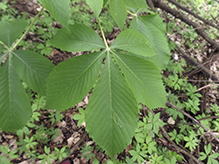 |
|||||
Randy |
|||||
Ohio buckeye in flower, May 2017, Freeborn County, MN |
|||||
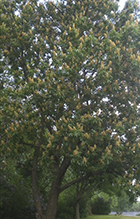 |
|||||
Fruit of an Ohio buckeye tree, Freeborn County, MN, July 2017 |
|||||
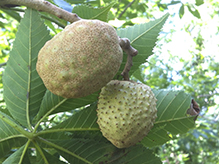 |
|||||
MinnesotaSeasons.com Photos |
|||||
Leaves |
|||||
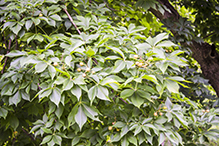 |
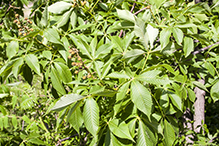 |
||||
Leaf |
five leaflets | 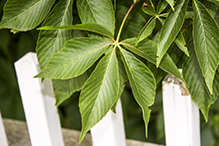 |
|||
seven leaflets |
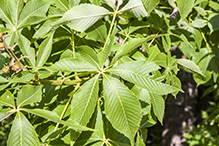 |
||||
Infructescence |
|||||
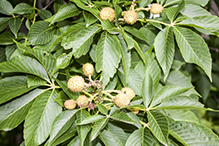 |
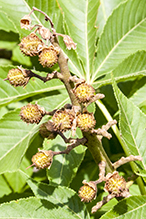 |
||||
Fruit |
|||||
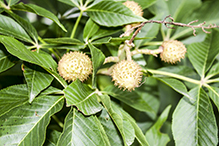 |
|||||

Slideshows |
||

Visitor Videos |
|||
Share your video of this plant. |
|||
| This button not working for you? Simply email us at info@MinnesotaSeasons.com. Attach a video, a YouTube link, or a cloud storage link. |
|||
Other Videos |
|||
| Trees with Don Leopold - Ohio buckeye ESFNature |
|||
About
Published on Jan 6, 2014 Don Leopold demonstrates the characteristics of Ohio buckeye. Content produced by Christopher Baycura for the SUNY College of Environmental Science and Forestry (SUNY-ESF). |
|||
| Aesculus glabra (Stan Hokanson).wmv TheCampusTrees |
|||
About
Published on Apr 25, 2012 Professor Stan Hokanson discussing the Ohio Buckeye Tree (Aesculus glabra) as a Minnesota landscape tree. |
|||

Visitor Sightings |
|||||
Report a sighting of this plant. |
|||||
| This button not working for you? Simply email us at info@MinnesotaSeasons.com. Be sure to include a location. |
|||||
| Luciearl 5/21/2019 |
Location: Owatonna, MN Growing crooked in the center of the woods, about 10 ft. tall. Planted by squirrels. |
 |
|||
| Randy Kogel May 2017 |
Location: Freeborn County, MN Ohio buckeye in flower |
 |
|||
| Randy Kogel July 2017 |
Location: Freeborn County, MN Fruit of an Ohio buckeye tree |
 |
|||
MinnesotaSeasons.com Sightings |
|||||

Created: 7/29/2017
Last Updated:
